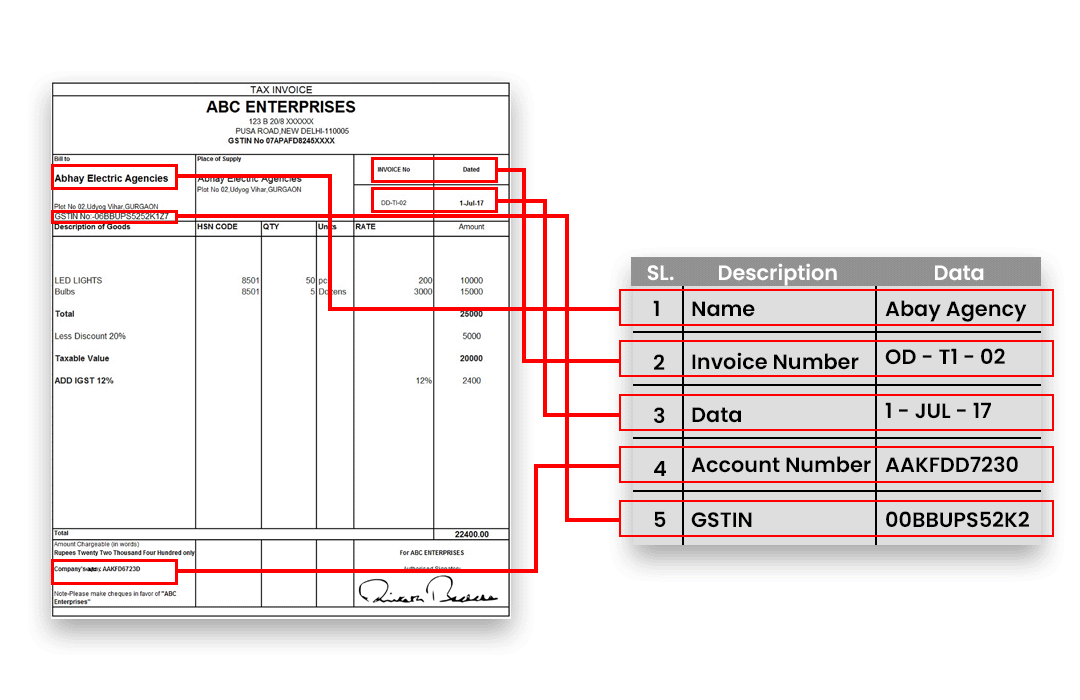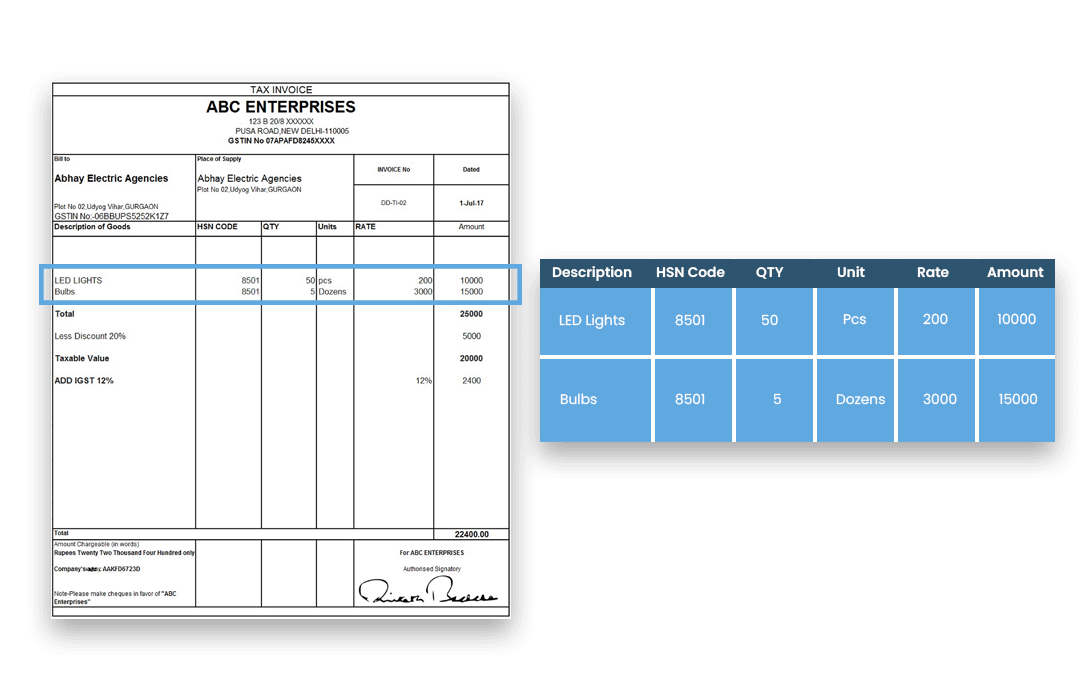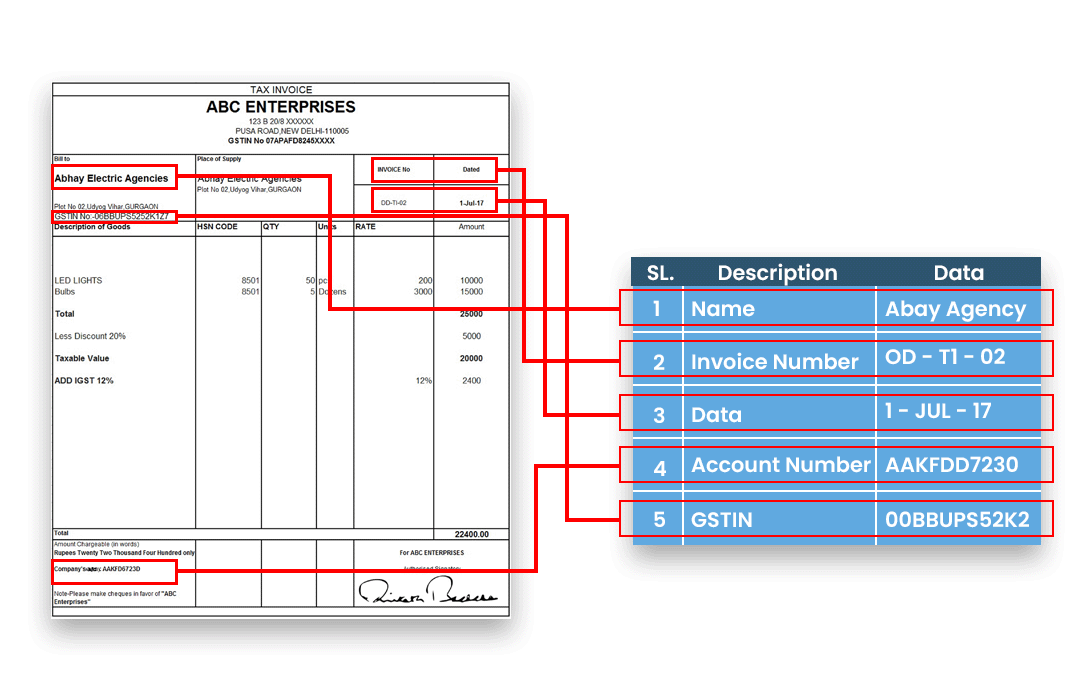How Invoice Data Extraction using Invoice OCR become an efficient way of Data Processing?
OCR(Optical Character Recognition) is an important technology in today's digital world. It can convert images with text into formats that can be edited and searched. This technology automates the extraction of data from printed or handwritten documents, making data entry faster and more accurate.OCR also helps people with visual impairments by making text accessible through special tools.Invoice ocr is a tool works in OCR technology.
It can also translate languages and analyse content. OCR is useful for managing documents, processing forms, preserving old texts, and making mobile apps more powerful. Its main benefits are unlocking valuable information, making processes more efficient, and connecting physical and digital worlds. Invoice ocr have benefits in large enterprises too.
What is Invoice OCR ?
Invoice OCR (Optical Character Recognition) API solutions are software interfaces that allow developers to integrate OCR functionality into their invoice data extraction services.Technology enables computers to recognize and extract data from invoice documents, making it possible to convert images of invoice into editable and searchable digital formats.

What is Role of OCR in Invoice data extraction ?
It can also translate languages and analyse content. OCR is useful for managing documents, processing forms, preserving old texts, and making mobile apps more powerful. Its main benefits are unlocking valuable information, making processes more efficient, and connecting physical and digital worlds. For large enterprises, invoice OCR offers significant benefits by automating invoice processing, reducing errors, accelerating workflows, and improving financial management at scale
An invoice data extraction software is a specialized application or tool that uses Optical Character Recognition (OCR) technology to extract data from invoices. OCR technology enables computers to recognize and convert text within images, such as scanned paper invoices or digital images of invoices, into machine-readable and editable data.
When it comes to invoice processing, Invoice OCR readers have many use cases across various industrys are used to automatically capture relevant information from invoices, such as the vendor's name, invoice number, date, line items, and total amount. The extracted data can then be further processed and integrated into accounting systems, ERP (Enterprise Resource Planning) software, or other financial management systems.
What Data's we can extract from Invoice in an efficient manner?
Our Invoice OCR APIs are designed to extract various data fields commonly found in invoices. Some of the typical data that can be extracted from invoices using pixl’s OCR API include:

- Invoice Number: The unique identifier assigned to the invoice, which is essential for tracking and reference purposes.
- Invoice Date: The date when the invoice was issued or generated.
- Due Date: The date by which the payment for the invoice is due.
- Vendor/Supplier Information: The details of the company or individual issuing the invoice, including name, address, and contact information.
- Customer/Buyer Information: The details of the customer or recipient of the invoice, including name, address, and contact information.
- Line Items:The individual items or services listed on the invoice, along with their descriptions, quantities, unit prices, and total amounts.
- Subtotals: The subtotals for each line item or group of items, before any taxes or discounts are applied.
- Taxes: The applicable taxes, such as VAT (Value Added Tax), GST (Goods and Services Tax), or sales tax, included in the invoice.
- Discounts: Any discounts applied to the invoice total.
- Total Amount: The total amount payable on the invoice, including taxes and discounts.
- Payment Terms: The terms and conditions for payment, including any early payment discounts or late payment penalties.
Invoice annotation
Invoice annotation refers to the process of labeling or annotating the contents of an invoice to make it recognizable by computer vision or natural language processing (NLP) algorithms. This involves labeling specific data fields within the invoice, such as invoice number, date, amount, and other relevant information
By annotating invoices, the labeled data becomes easier to feed into machine learning algorithms or programming to be interpreted accurately. It helps train models to recognize and extract data from invoices, enabling automation and streamlining of invoice processing workflows
The annotation process typically involves manual human effort, where annotators go through each invoice and identify and label the desired data fields. This annotated data is then used to train machine learning models to identify and extract the same data patterns in new invoices with high accuracy
Invoice annotation is crucial for developing robust invoice processing systems, as it enables the model to understand and extract the relevant information from invoices, reducing the need for manual data entry and improving efficiency and accuracy. It plays a vital role in automating invoice processing tasks, saving time and resources for businesses.
- Textual Annotations: Textual annotations involve adding comments or notes in the form of text to certain parts of an invoice. For example, an accounts payable team member might annotate an unclear or unusual item description with a note explaining the correct account code or category. These annotations help ensure that everyone who reviews the invoice understands any special considerations or adjustments.
- Visual Annotations: Visual annotations involve marking or highlighting specific areas on an invoice using shapes, lines, or symbols. This can be particularly useful for drawing attention to discrepancies, errors, or items that require special attention. Visual annotations can include arrows pointing to specific line items, circles around total amounts, or underlines to emphasize important information.
Pixl’s Table Extraction OCR
Pixl’s Table OCR (Optical Character Recognition) is a technology that extracts data from tables in various formats, such as scanned photos or PDF documents, using machine learning and artificial intelligence algorithms. It automates the detection and conversion of tabular data into structured forms such as Excel spreadsheets, removing the need for manual data entry. Table OCR is becoming increasingly significant for businesses because it enables faster and more accurate data processing, decreasing errors and enhancing productivity. It has applications in a wide range of industries, including finance, healthcare, and retail, and it is a crucial tool for any business that deals with big amounts of data.

Table OCR algorithms are designed to identify the rows, columns, and cells of a table and extract the text content accurately. This process involves recognizing the text within each cell and preserving the tabular structure of the original content. The extracted data can then be used for various purposes, such as data analysis, data entry automation, or integration into databases and spreadsheets.
AI-Enabled Automation
- Scanning or Uploading: Invoices are scanned or digitally uploaded into a system that can process OCR.
- Table Detection: The software identifies and locates tables within the invoice. This involves detecting rows, columns, and cell structures
- Data Extraction: The recognized characters are processed and interpreted, resulting in the extraction of structured data. This includes information like item names, quantities, prices, and totals.
- Validation and Correction: Some OCR systems offer validation and correction features to improve accuracy. Users can review and correct any misinterpreted data.
- Data Integration: The extracted data is integrated into the organization's systems, such as accounting software or databases, for further processing, analysis, and record-keeping.
Invoice table extraction OCR significantly speeds up the data entry process, reduces manual errors, and enhances overall accuracy. This technology is particularly valuable for businesses that deal with a high volume of invoices, as it frees up valuable human resources for more strategic tasks.
Pixl's Invoice OCR API Solutions
Our invoice OCR API solution sets itself apart by using modern computer vision technology, which goes beyond traditional OCR methods that rely on text recognition. Instead of just depending on the text content of invoices, our API focuses on analyzing the entire image to extract invoice data. By doing so, we eliminate language limitations, making it highly adaptable and capable of processing invoices from any part of the world.
Our innovative approach to annotating the invoice OCR model involved utilizing a vast dataset of invoices from different countries. This comprehensive annotation process ensures that our API can accurately extract data from invoices regardless of their country of origin and we can also customize the API according to the requirement.
With our advanced computer vision technology, businesses and organizations can now simplify their invoice data extraction workflows with unmatched accuracy and efficiency. By eliminating language barriers and incorporating a wide range of invoice formats, our API significantly reduces the need for manual data entry and minimizes the risk of errors. As a result, companies can experience increased productivity, cost savings, and real-time insights into their financial data, ultimately improving overall operational efficiency and decision-making processes.
Top Reasons to Opt for Pixl's Invoice OCR
You can extract data from invoices with the Pixl Invoice Extract API quickly and on a large scale. With our rapid invoice OCR API, you can lower costs substantially, drive up efficiency and deliver engagement via digital image processing.
Invoice Annotation And Training
Invoice annotation and training refer to the process of labeling and categorizing data from invoices to create a machine learning model capable of recognizing and extracting data from new invoices.
Capture data from any source
Easily capture and import data from diverse sources and formats, such as images, PDFs, scans, paper documents, emails, cloud storage platforms, APIs, and more. Our system is designed to handle a wide range of data inputs, ensuring seamless data extraction and integration for your convenience.
Extract data with superior accuracy
Benefit from our OCR APIs that undergo rigorous testing and come pre-trained on vast document datasets, guaranteeing exceptional accuracy and reliability right from the start.
Simplify workflows and operations
Create fully automated workflows that seamlessly manage file imports, data formatting, validation, approval processes, exports, and integrations. Our system ensures efficient and hassle-free handling of your entire workflow from start to finish.
Highly Accurate Results
Deep learning surpasses traditional OCR by combining visual features and natural language models to accurately recognize text, numbers, and symbols. It minimizes errors and provides downstream benefits, such as reducing financial loss and late penalty fees, due to its exceptional accuracy.
Get StartedHow can you test Pixl’s invoice data extraction ?
Upload Document
Businesses often have to manage invoices in both paper and digital formats, which can lead to confusion and potential errors. But now there's a better way. With our easy-to-integrate APIs, businesses can seamlessly upload paper and digital invoices in a single step.
With our API, you can upload invoices, regardless of whether they are in paper or digital formats, in just one simple step. The integration process is straightforward, allowing you to quickly implement the API into their existing systems or applications. Once integrated, employees can easily upload both paper-based and digital invoices without any extra effort or training.
Overall, our easy-to-integrate invoice data extraction API offer businesses a powerful tool to manage invoices effortlessly, regardless of their format. By simplifying the invoicing process and minimizing errors, businesses can save valuable time, reduce operational costs, and improve overall efficiency in their accounts payable processes.

Extract Data
Utilizing optical character recognition (OCR) and machine learning (ML)to manage and extract value from unstructured invoice data and automatically digitize, classify, normalize, and structure all essential invoice fields (ML).
By using optical character recognition (OCR) and machine learning (ML), our invoice data extraction API efficiently manages unstructured invoice data, extracting valuable information and automatically digitizing, classifying, normalizing, and organizing all crucial invoice fields. With OCR, we can accurately convert paper-based and digital invoices into machine-readable text, while ML enables the system to intelligently understand and categorize the data. This powerful combination ensures that businesses can effortlessly process and utilize invoice data, leading to enhanced accuracy, time savings, and streamlined accounts payable processes.
Delivery Data
Format that represents simple data structures with standardized data feeds such as JSON, Plain text or in Excel.
Conclusion
Invoice OCR API solutions offer a powerful tool for businesses to automate and streamline their invoice processing workflows. With their time-saving capabilities, accuracy, and cost efficiency, these solutions can transform how invoice data is extracted and processed, leading to enhanced productivity and improved operational efficiency.
The accuracy of OCR technology ensures precise data extraction even from diverse and complex invoice formats. This precision translates into reliable financial records, reducing the risk of compliance issues and financial inconsistency
Overall, our easy-to-integrate invoice data extraction API offer businesses a powerful tool to manage invoices effortlessly, regardless of their format. By simplifying the invoicing process and minimizing errors, businesses can save valuable time, reduce operational costs, and improve overall efficiency in their accounts payable processes.
As a result, businesses adopting invoice OCR API solutions can experience increased productivity, improved operational efficiency, and better control over their financial processes. The reduced manual intervention, increased accuracy, and faster invoice processing ultimately lead to greater cost savings, optimized resource allocation, and a competitive edge in the market. With these advantages, invoice OCR API solutions become a crucial enabler of growth and success for businesses of all sizes.